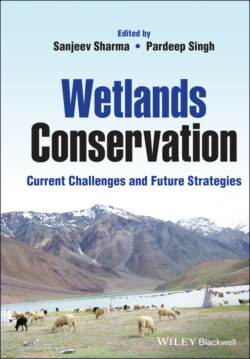Читать книгу Wetlands Conservation - Группа авторов - Страница 12
1.1 Wetlands Definition, Categorization and Classification Criteria
ОглавлениеWetlands form a crucial part of the socio‐ecological system as they are a storehouse of numerous ecosystems services. Wetland systems manage hydrological processes and preserve the natural ecological system to regulate the ecological balance and well‐being of humanity. Economic interests of the environment of the wetlands have not been recognised yet by policy planners and decision‐makers, neither at the global level, nor at regional levels. Wetlands are distributed in all geographical regions and climate zones of the planet earth. Globally and nationally, many attempts have been made to assess and identify the wetlands systems (Hu et al., 2017; Cowardin et al. 1979; Briggs 1981; Paijmans et al. 1985; Scott 1989; Gopal 1977; Gopal and Sah 1995). These wetlands systems are the most resourceful and important ecosystem on terrestrial as well as aquatic systems. Various elements of wetland, including geomorphology, hydrology, vegetation, water chemistry or substratum characteristics, have been emphasised by different classification schemes.
Globally, wetland systems are classified according to their origin, use, hydrology, composition, water level, physical and chemical characteristics (Gopal et al. 1990). Stanton (1975) suggested that Queensland wetlands be categorised into inland wetlands and coastal wetlands, which can be further divided on the basis of vegetation (i.e. mangroves, salt water meadows, salt marshes and salt mudflats), flood length and frequency. Cowardin et al. (1979) introduced a hierarchy consisting of wetland structures, subsystems, and groups, which is the most detailed classification scheme developed till date. The techniques and subsystems are based on geomorphological principles, while the groups usually stress the existence of substratum and physiognomy of the vegetation. Hydrology, water chemistry, and soil features are used as modifiers at the class and subclass level. A significant drawback of the classification developed by Cowardin (1997) is its uncertainty for practical purposes. Briggs (1981) classified the wetlands on the basis of vegetation. Paijmans et al. (1985) arranged them based on vegetation and hydrology. In an attempt to categorise the wide range of wetlands covered by the Ramsar definition, Scott (1989) identified 30 groups of natural and man‐made wetlands. Gopal and Sah (1995) proposed wetlands classification in India based on vegetation types that define specific hydrological regimes.
Wetland is a general term used for all kinds of ecosystems that stay wet for a period that is necessary for them to act as habitats. The term ‘WETLAND’ was first used officially in 1956 in the U.S. newspaper. The operation for Fish and Wildlife (Martin et al. 1953; Shaw and Fredine 1956; Tiner 2005) defined “wetlands as lowlands covered with shallow and sometimes temporary or intermittent waters referred to by such names as marshes, swamps, bogs, wet meadows, potholes, sloughs, and river‐overflow lands”. Many scientists across the world have defined and written widely about wetlands after 1953. The most popular wetland definitions are: 'The wetlands are lands where saturation with water is the dominant factor determining the nature of soil development and the types of plant and animal communities living in the soil and on its surface (Cowardin et al. 1979)’. This definition was later adopted by the U.S. Fish and Wildlife Service. Wetlands are defined as 'lands transitional between terrestrial and aquatic ecosystem systems where the water table is usually at or near the surface, or the land is covered by shallow water' (Mitsch and Gosselink 1986 ). ‘A wetland is an ecosystem that arises when inundation by water produces soils which are dominated by anaerobic processes, which, in turn, forces the biota, particularly rooted plants, to adapt with flooding' (Keddy 2010).
The Australian Convention (Hart et al. 1990; Semeniuk and Semeniuk 1995) defines wetlands as:
“Areas of seasonally, intermittently, or permanently waterlogged soils or inundated land, whether natural or otherwise, fresh or saline.”
The Canadian wetland classification system (Zoltai and Vitt 1995; Warner and Rubec 1997) defines wetlands as:
“Land that is saturated with water long enough to promote wetland or aquatic processes as indicated by poorly drained soils, hydrophytic vegetation, and various kinds of biological activity which are adapted to a wet environment.”
The Department of Conservation, New Zealand, (Johnson and Gerbeaux 2004) defines wetlands as:
“Permanently or intermittently wet areas, shallow water, or land water margins that support a net ecosystem system of plants and animals that are adapted to wet conditions.”
Classification of wetlands and deep water habitats of the United States (Cowardin et al. 1979) defines wetlands as:
“Lands transitional between terrestrial and aquatic systems where the water table is usually at or near the surface or the land is covered by shallow water.”
The Ramsar Convention on Wetlands gave the most widely recognized and accepted definition of wetlands. It defines wetlands as: 'The areas of marsh, fen, peatland or water, whether natural or artificial, permanent or temporary, with water that is static or flowing, fresh, brackish or salt, including areas of marine water the depth of which at low tide does not exceed six meters' (Finlayson and Moser 1991). Wetlands being transitional areas tend to possess characteristics of both terrestrial and aquatic systems, which are unique ecosystems in themselves.
